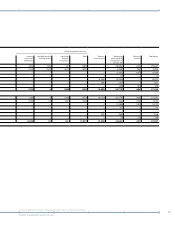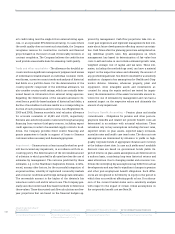Siemens 2009 Annual Report Download - page 225
Download and view the complete annual report
Please find page 225 of the 2009 Siemens annual report below. You can navigate through the pages in the report by either clicking on the pages listed below, or by using the keyword search tool below to find specific information within the annual report.
Managing Board statements, Independent auditors’ report, Additional information
Notes to Consolidated Financial Statements
(in millions of €, except where otherwise
stated and per share amounts)
MANAGEMENT ESTIMATES AND JUDGMENTS
Siemens’ Consolidated Financial Statements are prepared in
accordance with IFRS. Siemens’ significant accounting poli-
cies, as described in Note 2, are essential to understanding the
Company ’s results of operations, financial positions and cash
flows. Certain of these accounting policies require critical ac-
counting estimates that involve complex and subjective judg-
ments and the use of assumptions, some of which may be for
matters that are inherently uncertain and susceptible to
change. Such critical accounting estimates could change from
period to period and have a material impact on the Company ’s
results of operations, financial positions and cash flows.
Critical accounting estimates could also involve estimates
where management reasonably could have used a different
estimate in the current accounting period. Management cau-
tions that future events often vary from forecasts and that esti-
mates routinely require adjustment.
Revenue recognition on construction contracts – The Com-
pany ’s Sectors, particularly Energy and Industry, conduct a
significant portion of their business under construction con-
tracts with customers. The Company generally accounts for
construction projects using the percentage-of-completion
method, recognizing revenue as performance on a contract
progresses. This method places considerable importance on
accurate estimates of the extent of progress towards comple-
tion. Depending on the methodology to determine contract
progress, the significant estimates include total contract costs,
remaining costs to completion, total contract revenues, con-
tract risks and other judgments. Management of the operating
Divisions continually reviews all estimates involved in such
construction contracts and adjusts them as necessary. The
Company also uses the percentage-of-completion method for
projects financed directly or indirectly by Siemens. In order to
qualify for such accounting, the credit quality of the customer
must meet certain minimum parameters as evidenced by the
customer’s credit rating or by a credit analysis performed by
Siemens Financial Services (SFS), which performs such re-
views on behalf of the Company ’s Managing Board. In addi-
tion, to qualify for such accounting, at a minimum, a custom-
In January 2008, the IASB published the revised standards
IFRS 3, Business Combinations (IFRS 3 (2008)) and IAS 27, Con-
solidated and Separate Financial Statements (IAS 27 (2008))
which were endorsed in fiscal 2009. The revised standards are
effective for business combinations in annual periods begin-
ning on or after July 1, 2009.
IFRS 3 (2008) reconsiders the application of acquisition ac-
counting for business combinations. Major changes relate to
the measurement of non-controlling interests, the accounting
for business combinations achieved in stages as well as the
treatment of contingent consideration and acquisition-related
costs. Based on the new regulation, non-controlling interests
may be measured at their fair value (full-goodwill-methodol-
ogy) or at the proportional fair value of assets acquired and li-
abilities assumed. In business combinations achieved in
stages, any previously held equity interest in the acquiree is
remeasured to its acquisition date fair value. Any changes to
contingent consideration classified as a liability at the acquisi-
tion date are recognized in profit and loss. Acquisition-related
costs are expensed in the period incurred.
Major changes in relation to IAS 27 (2008) relate to the ac-
counting for transactions which do not result in a change of
control as well as to those leading to a loss of control. If there is
no loss of control, transactions with non-controlling interests
are accounted for as equity transactions not affecting profit
and loss. At the date control is lost, any retained equity inter-
ests are re-measured to fair value. Based on the amended stan-
dard, non-controlling interests may show a deficit balance
since both profits and losses are allocated to the shareholders
based on their equity interests.
Beginning in fiscal 2010, the Company intends to present total
interest income and expense separately in the consolidated
statements of income in accordance with Part II of the Annual
Improvements Project 2008 of the IASB.
The IASB issued various other pronouncements. The recently
adopted pronouncements as well as pronouncements not yet
adopted do not have a material impact on Siemens’ Consoli-
dated Financial Statements.
























